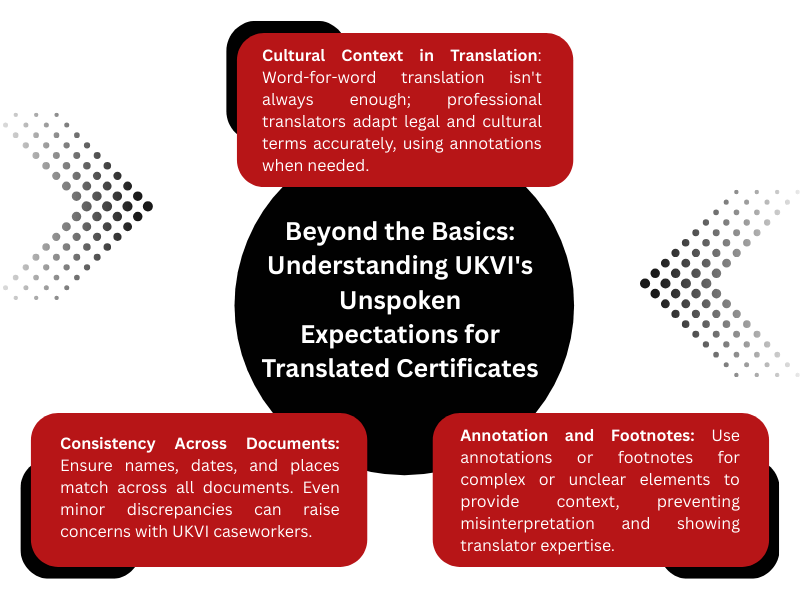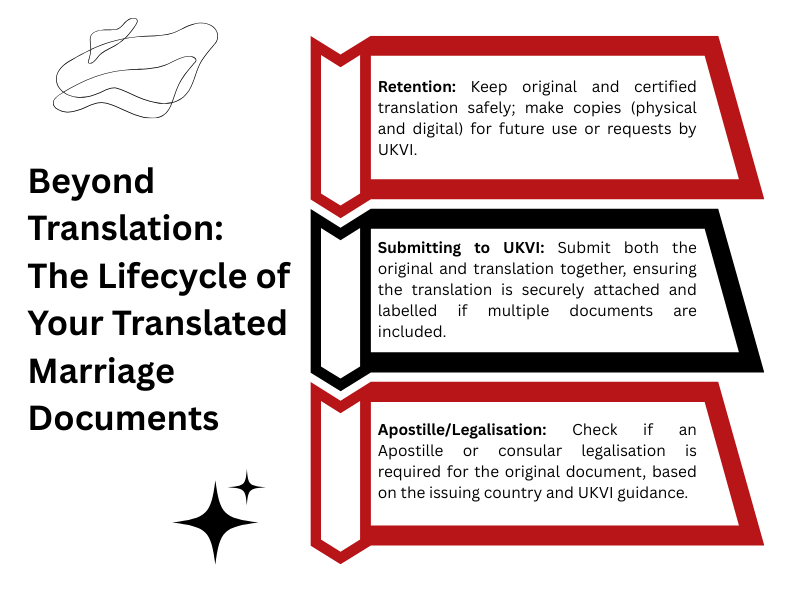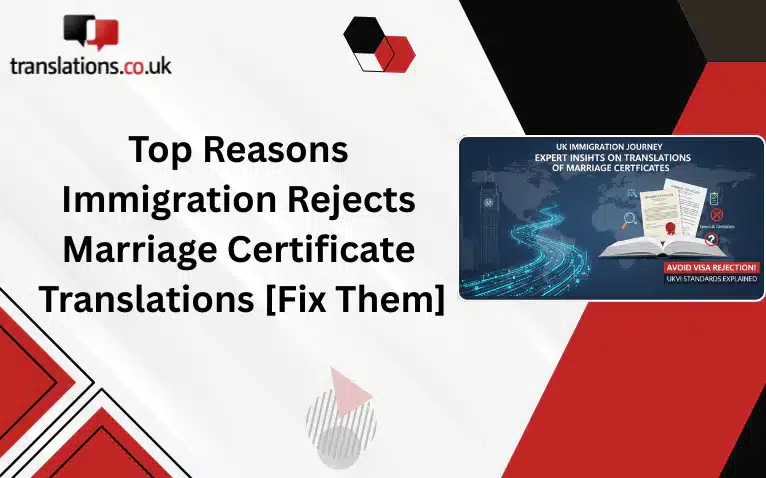Planning to migrate to the UK? Commencing a UK immigration journey is an exciting prospect, but the administrative hurdles, particularly those related to official documents, can be daunting.
Your marriage certificate is often a cornerstone document for many visa applications, from spousal to family routes. However, simply getting it translated isn’t enough. The UK Home Office (UKVI) has stringent, sometimes unspoken, expectations for translated documents. A single error or oversight in your marriage certificate translation can lead to delays, requests for further information, or even outright rejection of your visa application.
This comprehensive guide will go beyond the basics, equipping you with expert insights to ensure your translated marriage certificate meets UKVI standards, safeguarding your immigration aspirations. Let’s understand why Immigration Authorities reject marriage certificate Translations (and how to avoid it).

While UKVI guidance specifies that a certified translation must accompany any document not in English or Welsh, there’s more to it than just changing the words. Meeting the unwritten rules can significantly smooth your application process.
Cultural Context in Translation:
Direct, word-for-word translation isn’t always sufficient. Some terms, legal structures, or cultural references in the original document may not have exact equivalents in English. A professional translator with experience in legal and immigration documents will understand how to accurately convey the meaning and legal intent, not just the literal words, often using explanations or annotations where necessary. For instance, specific regional marriage customs or titles of officials might require careful contextual translation. To know more, read “Common Mistakes to Avoid When Translating Legal Documents”.
Consistency Across Documents:
Names, dates, and places must be absolutely consistent across all submitted documents – your original certificate, the translated certificate, your passport, other identity documents, and the application forms themselves. Minor discrepancies, even a single letter in a name, can raise red flags for UKVI caseworkers. Applicants must meticulously review all documents for consistency before submission, especially regarding the transliteration of names.
Annotation and Footnotes:
Why Immigration Authorities Reject Marriage Certificate Translations: Real-World Scenarios & Solutions

Exploring document translation can be fraught with potential missteps. Here, we explore common scenarios that lead to rejection or delays, highlighting common mistakes in marriage certificate translation for UK visas and offering practical solutions.
Scenario 1: The “DIY” Disaster
- Problem: Applicants attempting to translate their own certificates or asking a bilingual friend/family member. UKVI explicitly states that self-translations are not accepted. Even if the individual is fluent, they lack the official certification and independent verification required by the Home Office.
- Impact: Automatic rejection or a request for a proper certified translation, leading to significant delays, additional costs, and considerable stress.
- Solution: Always use a professional translation service that is independent and certified. The translator must be accredited (e.g., by ITI or CIOL in the UK) and provide a signed statement confirming their credentials, the accuracy of the translation, and their full contact details.
Scenario 2: The Illegible Original
- Problem: Many marriage certificates, particularly older ones or those from certain regions, can be faded, poorly printed, handwritten, or partially obscured. A translator can only translate what they can read. If key parts are illegible, the translation will be incomplete or inaccurate.
- Impact: UKVI caseworkers are unable to verify crucial information, resulting in delayed or rejected applications.
- Solution: Obtain a clearer, certified copy of the original certificate from the issuing authority. If not, the translator should clearly mark any illegible sections in the translation (e.g., “[Illegible]”). It is advisable to supplement with an affidavit from the couple or a relevant authority explaining the illegibility and affirming the correct details.
Scenario 3: The “Budget Translator” Blunder
- Problem: Opting for the cheapest professional translation service without thoroughly vetting their qualifications or experience. These services may lack a nuanced understanding of specific legal terminology, UKVI marriage certificate translation requirements, or the critical importance of a proper certification statement.
- Impact: Translation errors, missing or insufficient certification statements, incorrect formatting, or delays in receiving the translation – all of which can severely compromise your application.
- Solution: Prioritise quality and expertise over cost. Research translation agencies or individual translators who specialise in immigration documents for the UK. Check their professional affiliations (e.g., Association of Translation Companies, Institute of Translation and Interpreting) and ask for sample certification statements to ensure they meet UKVI standards.
Specific UK Visa Routes: Translation Requirements for Spousal, Family, and Ancestry Visas
While the core requirement for certified translation services remains consistent across visa categories, understanding how your marriage certificate fits into specific routes is vital.
➞ Spousal Visas (Partner/Spouse Visas):
- This is the primary route where a marriage certificate is paramount proof of a genuine and subsisting relationship.
- The translated certificate must unequivocally prove the legal marriage, showing names, dates, and places aligning with other relationship evidence.
➞ Family Visas (e.g., Parent of a British Child, other dependent relatives):
- May require the marriage certificate to establish parental links or the relationship between sponsors and applicants, especially in complex family structures.
- Accuracy here is crucial for demonstrating eligibility based on family ties.
➞ Ancestry Visas:
- While primarily focused on ancestry, a marriage certificate might be needed to prove links in a chain of relationships to the UK-born grandparent, particularly if names have changed due to marriage or to establish direct lineal descent.
Beyond Translation: The Lifecycle of Your Translated Marriage Documents

Your translated marriage certificate isn’t just a piece of paper for submission; it has a lifecycle you need to manage carefully.
Retention:
Always keep both the original document and the certified translation safely. Make multiple copies (both physical and digital) of both documents before submission. UKVI may request to see the originals even after submission, or you may need them for future visa extensions, other administrative tasks in the UK, or even further immigration applications.
Submitting to UKVI:
Clearly state that both the original non-English certificate and the certified marriage certificate translation for UK immigration must be submitted together. Never send only the translation. Ensure the translation is securely attached to the original document (e.g., clipped together) and clearly labelled if multiple documents are being sent.
Apostille/Legalisation (if applicable):
Some countries require an Apostille or other form of legalisation on the original marriage certificate before it can be used internationally. An Apostille certifies the authenticity of the original document, not the translation. The UK is a signatory to the Hague Apostille Convention; therefore, if your original document’s issuing country is also a signatory, an Apostille may be required. If not, consular legalisation might be necessary. Always check specific UKVI guidance and the requirements of the issuing country.
Staying Compliant: Latest UKVI Updates Affecting Document Translations
UK immigration rules are dynamic. Staying informed about the latest changes affecting document translations is crucial for compliance. We encourage readers to regularly check the official UK government website (GOV.UK) for the most up-to-date guidance. Rules can change regarding acceptable certification bodies for translators, specific formatting requirements for translations, electronic submission guidelines for scanned documents and translations, or the need for additional declarations or specific details in the translation statement. For current, personalised advice, always consider consulting an immigration lawyer or an OISC-regulated advisor.
How to Avoid Errors in Marriage Certificate Translation UK?

Proactive steps can significantly reduce the risk of errors and enhance the success of your application.
- Choose a Reputable, Certified Translator: Get certified marriage certificate translation for UK immigration. Hire a translator accredited by recognised professional bodies (e.g., ITI, CIOL in the UK) or a reputable translation agency with experience in UK immigration.
- Provide Clear Originals: Ensure the original document is clear, legible, and complete before sending it for translation.
- Communicate Clearly: Inform your translator that the translation is for UK immigration purposes. Provide them with any specific instructions from UKVI if you have them.
- Verify Personal Details: Double-check all names, dates, and places in the translation against your original document and passport.
- Understand the Certification: Ensure the translation includes a signed statement from the translator/agency confirming:
- That it is a ‘true and accurate translation of the original document’.
- The date of translation.
- The full name and contact details of the translator or an official of the translation company.
- The translator or translation company’s professional qualifications/accreditations.
- Keep Records: Retain copies of all documents – originals, translations, translators’ credentials, and payment receipts.
Conclusion: Don’t Risk Your Visa – Choose Expert Certified Translation
Your UK immigration dream hinges on the meticulous preparation and submission of your application, and a correctly translated marriage certificate is a critical component. Don’t let avoidable translation errors jeopardise your future in the UK. Investing in an expert, certified translation ensures compliance with UKVI standards, provides peace of mind, and significantly strengthens your application. Choose wisely, and take a confident step towards your new life in the United Kingdom.
Frequently Asked Questions
Why Marriage Certificate Translations Get Rejected?
Common reasons include self-translation, uncertified translation, errors in names/dates/places, incomplete translation, an illegible original not addressed, a lack of a proper certification statement from the translator, or failure to submit both the original and translation.
Does the Format of the Translation Affect Acceptance by UKVI?
Yes, to some extent. While there isn’t one strict template, the translation should generally mirror the layout of the original document as much as possible for ease of comparison by caseworkers. Crucially, it must be clear, legible, and professionally presented, with the certification statement prominently included.
Are Self-translations of Marriage Certificates Accepted in the UK?
No, explicitly not for UK visa applications. UKVI guidance stipulates that a professional, independent translator or a translation company must complete translations.
Why Is Certified Translation Important for UK Immigration Applications?
Certified translation ensures that UKVI is assured that the document is an accurate and true representation of the original. It confirms the translator’s qualifications and accountability, establishing the reliability and credibility of the translated evidence, which is essential for legal and immigration purposes.
- Top Reasons Immigration Rejects Marriage Certificate Translations [Fix Them] - 5th October 2025
- Top Challenges And Solutions In Marriage Certificate - 28th November 2023
- What are the Legal Implications of Inaccurate Marriage Certificate? - 21st November 2023

